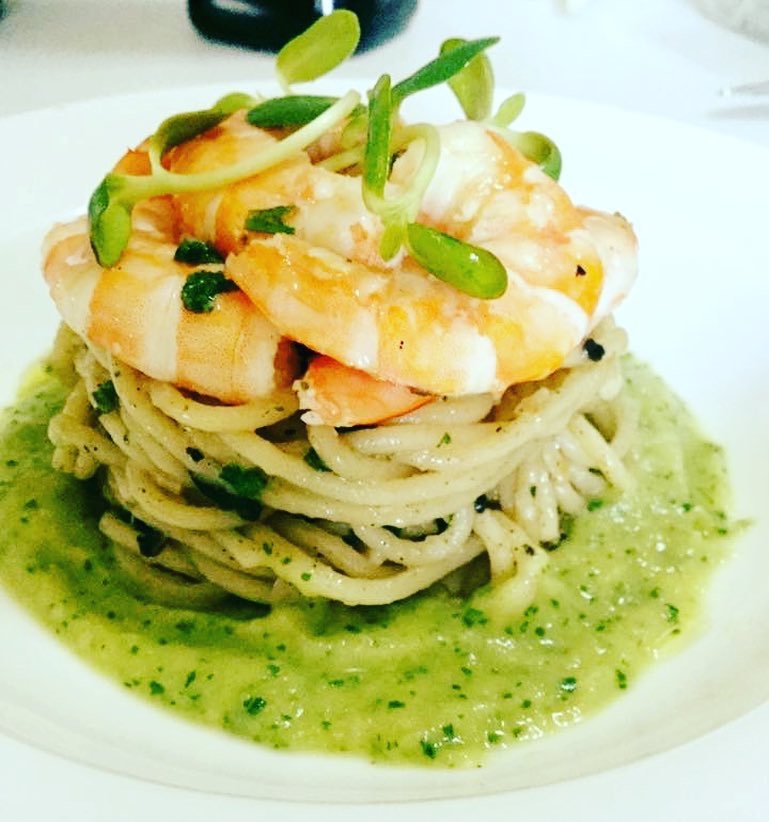
Organic spaghetti with powdered black truffles, prawns and zucchini-spinach sauce. In this dish, the writer cooked his prawns sous vide at 55.6 C for 35 minutes.
SOUS vide, the process of cooking food “under vacuum” at low, tightly controlled temperature in a water bath, revolutionized the culinary world when it was adopted as a culinary technique in the 70s in upscale restaurants in France.
Because it lets us cook at a temperature our food must be served at, the process yields precise doneness and texture we can hardly achieve by traditional cooking methods.
As a homecook who fancies modernist cooking and molecular gastronomy techniques, I started using sous vide around this time last year after I bought my first set of sous vide immersion circulator, a water bath container, sous vide rack, vacuum-sealing machine and (food-grade) vacuum bags. (SweetLink Inc. in Mandaluyong sells sous vide and vacuum-sealing machines for both professional and home kitchens. There are also reliable online sellers who have Facebook pages—Sous Vide Philippines and Sous Vide PH, for PolyScience and Anova brands, respectively. Some of the latest models have Bluetooth capabilities.)
In my MasterClass with Chef Gordon Ramsay, he was always emphatic about serving steak medium rare, which means serving it with an internal temperature of 55 C.
With traditional cooking methods, I’d cook my steak on a hot grill or oven at around 200 C-260 C.
I would have to check the meat’s internal temperature every so often, to ensure the exact doneness. In this process, you have to be at the right moment when temperature reaches 54 C or 55 C.
It leaves you no time to blink, or work on your red wine jus. No matter what, what you get is the “bulls-eye effect” of burnt meat on the outside turning to medium rare in the middle.
Cooking steak sous vide, however, at 54 or 55 C for several hours (depending on your steak cuts and thickness—2-8 hours for ribeye, and 2-3 hours for tenderloin) results in a perfectly cooked medium rare.
You can do a quick searing after, at high heat, to add flavor and a brown crust to it.
Red snapper with mango purée and coconut foam. Red snapper is sous vide at 60 C for 30 minutes.
When we do steak nights at home, I normally leave my steaks in the sous vide water bath in the morning before heading for work.
In the evening, when I reach home, I still have time to do my sauce, usually a simple red wine jus (I use port), and then pull out the steaks from the water bath and sear it right before serving.
Like other traditional cooking methods, it is wise to season the food before vacuum-sealing it and putting it in the water bath.
For my steak, I just sprinkle salt and pepper before placing it in the vacuum bag, add a knob of butter or a modest amount of olive oil, a sprig of thyme or laurel leaf for aroma, before vacuum-sealing the pouch. (Remember to place only a portion of steak in every pouch or vacuum bag.)
If you don’t have a vacuum sealer (a vacuum-sealing machine costs at least P15,000 to P16,000), you can use your Ziploc freezer bags and apply the Archimedes principle or water displacement method (hold the bag underwater with the top part sticking out, letting the water pressure force out the air from the bag, before zipping the bag close).
Now, in my kitchen, I cook everything sous vide—from fruits and vegetables to fish and shellfish to chicken, French duck, pork, and lamb. I even sous vide eggs.
